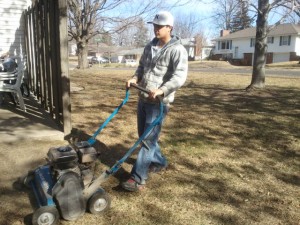Spring is finally here and homeowners are always excited to get outside and start working on their lawns. Sometimes this may lead to wanting to do some spring seeding. Before deciding to seed this spring you may want to consider the disadvantages.
Spring seeding disadvantages
Spring seeding has a few drawbacks which need to be understood. By seeding in the spring you will have to delay your pre-emergent for crabgrass and foxtail until the new grass is well established. Delaying the pre-emergent may allow crabgrass and other grassey weeds to germinate and invade the lawn. Controlling grassy weeds with a pre-emergent is a lot easier than trying to control them after they have sprouted. Crabgrass pre-emergents prevent weed seeds from germinating, which is what it will do to your grass seed. So remember, no crabgrass control until your new seed is well established, at least a couple inches high.
Controlling grassy weeds with a pre-emergent is a lot easier than trying to control them after they have sprouted. Crabgrass pre-emergents prevent weed seeds from germinating, which is what it will do to your grass seed. So remember, no crabgrass control until your new seed is well established, at least a couple inches high.
Why seeding in the fall may be better
The second disadvantage about seeding in the spring is that the new grass plants have a much tougher time surviving the summer’s heat and stress. Bluegrass and fescue grasses are cool season grasses that thrive in temperatures between 68 to 77⁰F. At these temperatures the plant is able to manufacture food for top growth and just as importantly root reserves. 68 to 77⁰ temperature ranges occur twice a year, in the spring and fall. By seeding in the fall the lawn has the benefit of producing food during the fall and spring. Roots will have the fall, winter and spring to build up carbohydrate reserves to get through the summer stresses. Spring seeding just does not give the grass plant enough time to build up its root reserves, which it uses to get through the summer. Read more about preparing your lawn for droughts.
Embarrassing dead spots may need seeding
Now, of course, if your lawn has large dead spots that are very obvious, and maybe embarrassing, sometimes you have no choice but to seed in the spring. Just remember the new grass may not have enough energy in its root system to make it through the summer. Which means, you may still have to seed in the fall to get a good, complete stand of grass.
Don’t forget, if you do seed in the spring, contact us so we can make appropriate changes to the spring applications. We ask our customers every winter to notify us if they are seeding so we can switch the pre-emergenct to a starter fertilizer to help the new seedlings get off to a stronger start.
